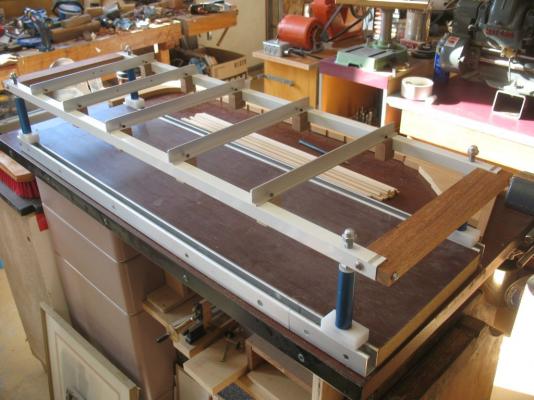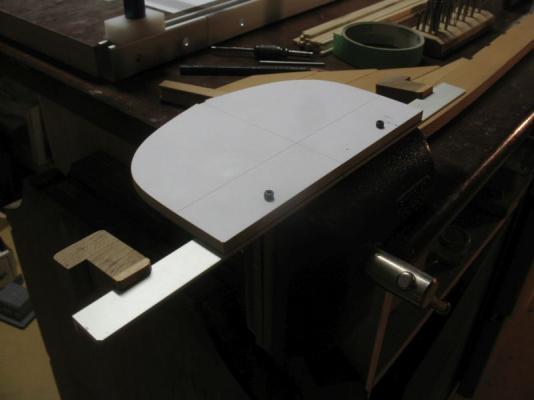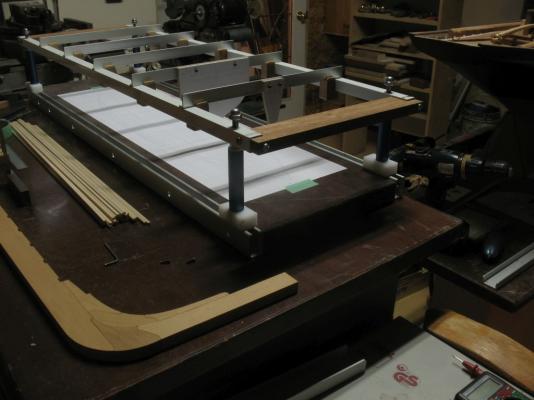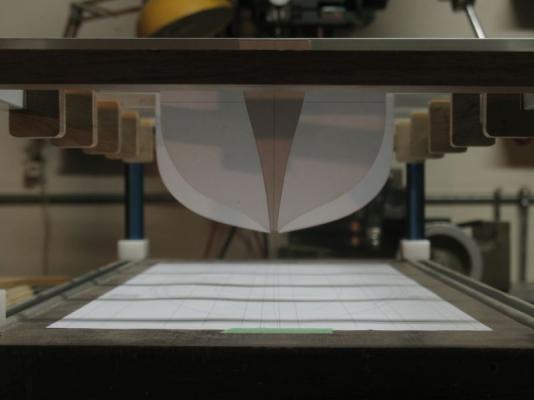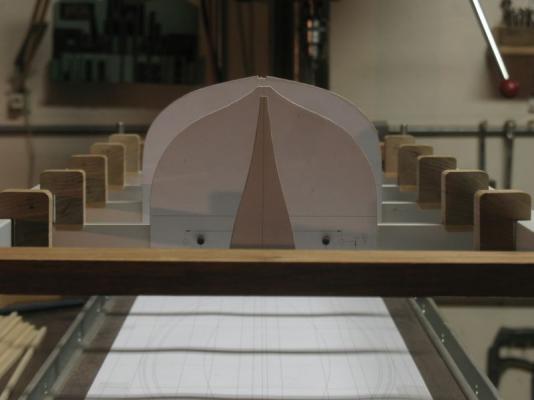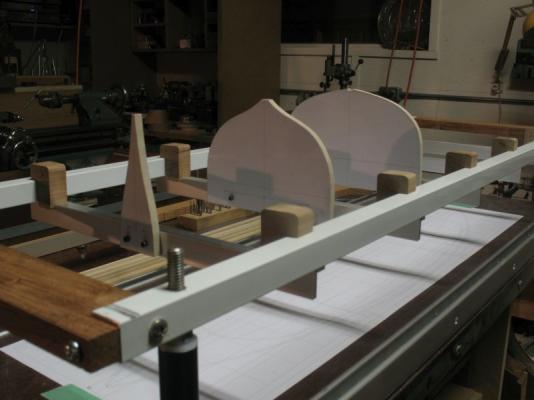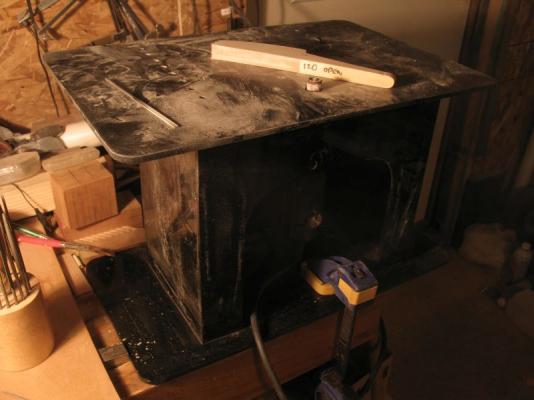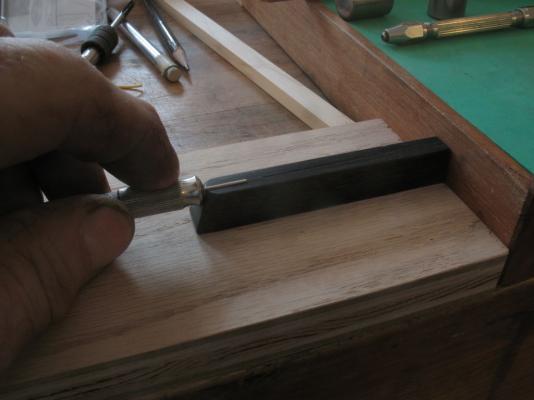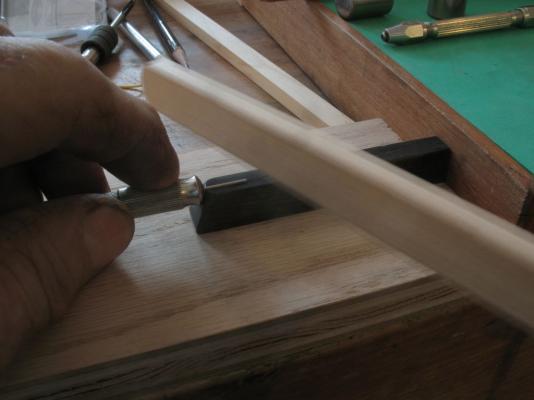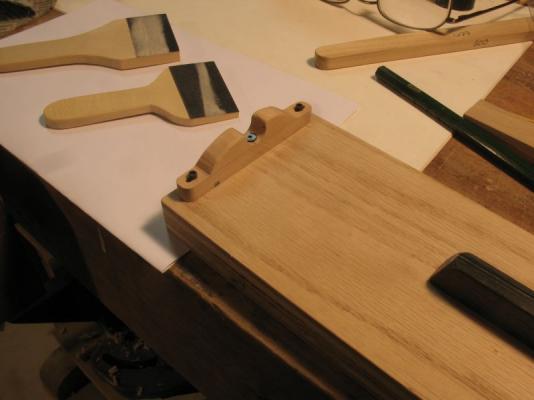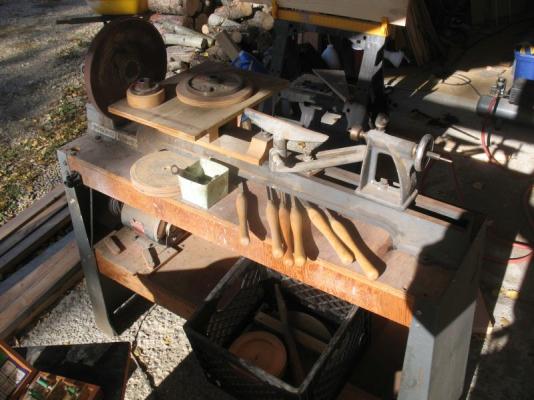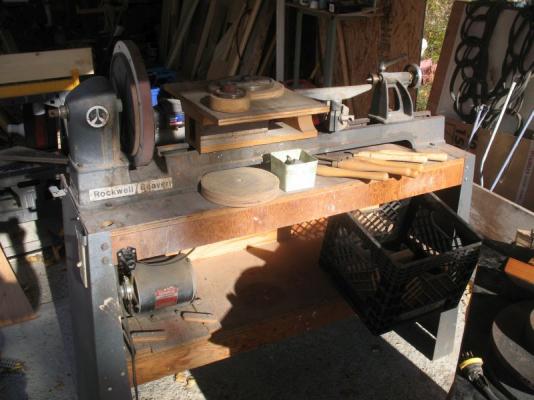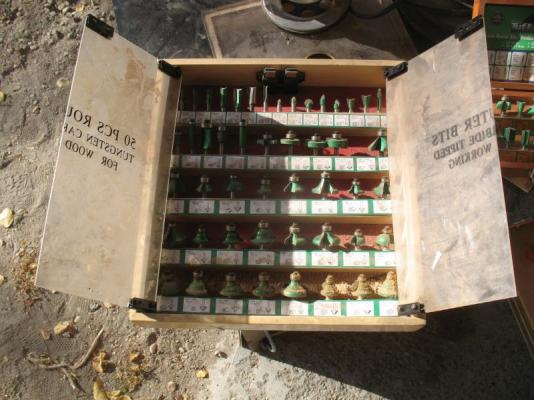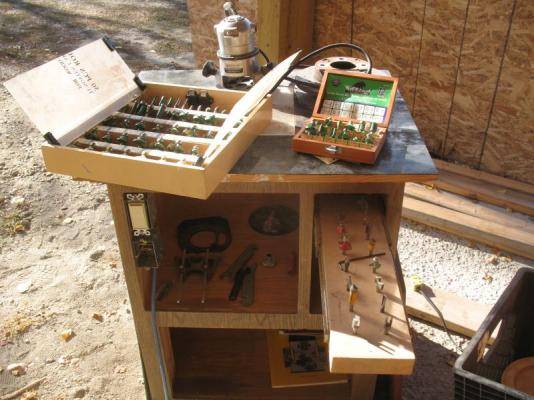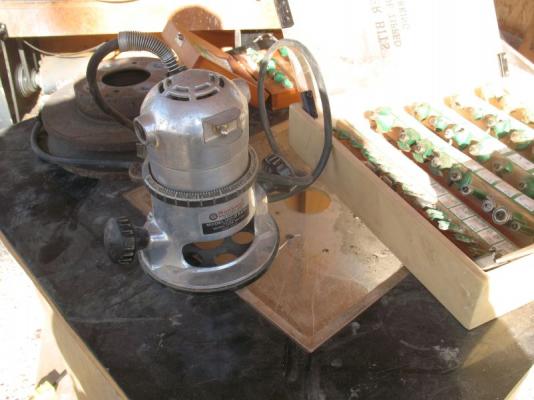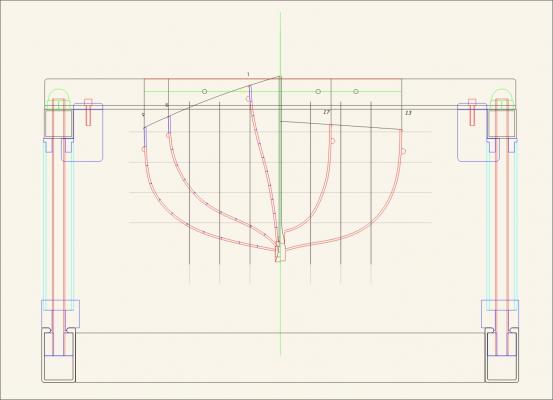-
Posts
5,195 -
Joined
-
Last visited
Content Type
Profiles
Forums
Gallery
Events
Everything posted by michael mott
-
Daniel this model is seriously small, I think I would be ready for a straightjacket by now. You are doing a great job BTW. Michael
- 36 replies
-
- bermuda sloop
- sloop
-
(and 2 more)
Tagged with:
-
After resizing the drawings I needed to modify the building jig, thinking about the sequence of construction I eliminated the keel support for the moment. The white rails were too short so a new pair were drilled. I had a scrap of Brazilian Rosewood which was just big enough for the new frame end bars. Some wood inserts were driven into the long tubes before the holes were drilled the frame is now quite rigid. I have cut the first three new molds for the ribbands and mounted them on the aluminum cross beams. The molds were cut from 1/4 MDF and are set aft of the station lines, the last two will be set forward of the station Lines. The molds will not be faired, this why they are placed the way they are. the next pic shows the frame reversed on the build posts. you can see that they are not yet perfectly centered I will do this when all 5 molds are set on the cross beams before adding the keel. I am much happier with the building frame. I remembered that I had built and stored away a small Dremel routing/sanding table which was fabricated out of 1/4 inch thick black plexiglass. I used this table a lot when building Architectural models, I set it up for working on the molds along with some curved shaped sanding sticks. Michael
-
Actually the genus is tilia the main species of Tilia are T cordata from Europe, T americana American Basswood or Linden. T cordata is a small leafed lime and T americana has big leaves, these are the two main sources of wood. the lime timber is also used in the making of Charcoal for drawing. references "The Oxford Encyclopedia of TREES OF THE WORLD" ISBN0517616734 published in1981 One of the interesting things about organic materials like wood is that they are adapted to their environments.The wood from a tree that grows in one locale can be exactly the same species as that of tree and in a different locale and the wood from the second tree could be completely different to work because of the soil conditions and mineral content affect the growth and thus the texture and properties of the wood. Michael
-

Wood Lathe and Router table
michael mott replied to michael mott's topic in Modeling tools and Workshop Equipment
I talked with my youngest son in Calgary today because it is his birthday and during our conversation he was telling me about how he was thinking yesterday about how nice it would be to have a wood lathe, Well it was a no brainer for me to tell him "Happy birthday that I just happened to have a wood lathe that I would be cleaning up and taking it down for him" Life does work in mysterious ways. Michael -

Dewalt 788 Scroll Saw Steal
michael mott replied to FlounderFillet5's topic in Modeling tools and Workshop Equipment
Congratulations Max, it really is great when the stars align in the universe. Michael -
Mike, just went through your log. An outstanding job on the longboat. congratulation on a superb looking model. Michael
- 109 replies
-
- 18th century longboat
- model shipways
-
(and 1 more)
Tagged with:
-
Dan, one way to deal with small diameter spars is to make them from square stock, rather than dowels. I made this jig from a recycled ebony piano key and a few bits of scrap. the wood was chucked in a pin vice, and sanding sticks used to shape the spar. I have just finished going through your entire build log, what a great job you have done the model is looking really fine. Michael
- 175 replies
-
- 18th century longboat
- model shipways
-
(and 1 more)
Tagged with:
-
Made me smile Ed, wonder if it is some long lost relative? Stunning workmanship as always Ed, I would agree about the use of card for the simulations of sheet steel. The shellac treatment really gives it a lot of strength, reminds me of the model books about building structures for model railways that I read as a kid. Michael
- 3,618 replies
-
- young america
- clipper
-
(and 1 more)
Tagged with:
-
Nils your work on the boom ends is lovely and the drawing that you sketched is a nice piece of artwork. Michael
-
last evening I was thinking about giving my friend Al a watercolour painting for all his help with launching Maria a month ago. The universe works in mysterious ways and demonstrates abundance when one is open to it. This morning my friend Al showed up with the following items and said do you want these. He was clearing up the floor of his shop to make room for the boats he will be working on over the winter. he is not a wood worker and was given these by his brother in law a few years back and never used them. It was such and easy answer. I do feel blessed this morning. They will need a bit of cleaning but all work perfectly, the carbide router bits are virtually brand new. The lathe was set up as a sander so it will go back to being a wood lathe. I need to rethink the size of the watercolour now. Michael
-

The Byrnes Saw "inside and around"
michael mott replied to nobotch's topic in Modeling tools and Workshop Equipment
The riving knife seems like a good idea, with the following caveat, if your saw is not fitted up for one it can be complicated to set it up so that it works as the video shows . I also see that one would need different thicknesses and heights to accommodate different blade widths and diameters. In the video the chap just drops the knife into a slot. the video uses styrofoam as a demo material, I would not cut Styrofoam on a table saw in the first place it is a sticky material that can grab regardless of slitters or knives. He also is using much thicker material than most model-builders would use. All that said safety is a concern, on long work top fingers clamped to the fence work very well. on short work a long push board or push sheet that engage with at least 6 to 9 inches of the length of wood are a hundred times safer than the tiny push stick that the chap used in the video, in fact it is my own personal opinion that the type of push stick that was used in the video should be made illegal to sell because they are inherently dangerous because of their design. There are many approaches to working safely, unfortunately not all of them are transferable to working with very small pieces of wood. I have seen kickbacks and in one case the wood a piece of 1/4 inch by 1/2 inch maple that was wedged between the fence and the blade was ejected horizontally and went right through a gallon can of paint 10 feet away like an arrow. Most of the incidents that occur are combination of poor set ups and rushing and not taking the time to set up the appropriate finger boards or hold down fingers or using a scrap bit of wood as a push tick that only has a miniscule grip on the trailing edge. My advice is hold it down properly in the first place, set the blade height according to the thickness of the wood, use zero clearance insets, change them regularly as they wear or for different thicknesses. Happy cutting Michael -

The Byrnes Saw "inside and around"
michael mott replied to nobotch's topic in Modeling tools and Workshop Equipment
The problem with splitters is that can get in the way when cutting low rabbets and other small accurate cuts. I have always found them more trouble than they are worth. But hey that just me. Michael -
Bob, Tom, Carl, thanks for stopping by, and to those who are watching from the sidelines. I realized the lines drawing in the building jig was the wrong scale it was 1:10 instead of 1:8 which made a pretty big difference so I have been reworking the drawing in my spare time, also a little tweaking of the hull profiles and planking layout and keel sections. this is the progress so far on the changes october 6 body profiles.pdf Michael
-
Very nice workmanship on the tiny sheave and related wooden parts Danny, you could have been a watchmaker in a former life Michael
-
Stuntflyer, I think that you could do it with a sawblade which is designed for wood, I would not do it with a cutoff blade which is not really designed for wood. You simply have to think horizontally instead of vertically, I personally would think a bit of lateral thinking and a handsaw and a file or chisel to clean up would be the easiest, I say that because the amount of material is quite small that will be removed. In fact a little setting up and a couple of different files one coarse and one fine would likely accomplish the task in half the time. Michael
-
looking for the jig for the jewelers saw I found the chap who I was looking for, William Robertson designed a special holder to cut dovetails and other joints with a jewelers saw, i am still looking for this jig but in the meantime enjoy his amazing work. I think we could all use a set of these tools. Michael
About us
Modelshipworld - Advancing Ship Modeling through Research
SSL Secured
Your security is important for us so this Website is SSL-Secured
NRG Mailing Address
Nautical Research Guild
237 South Lincoln Street
Westmont IL, 60559-1917
Model Ship World ® and the MSW logo are Registered Trademarks, and belong to the Nautical Research Guild (United States Patent and Trademark Office: No. 6,929,264 & No. 6,929,274, registered Dec. 20, 2022)
Helpful Links
About the NRG
If you enjoy building ship models that are historically accurate as well as beautiful, then The Nautical Research Guild (NRG) is just right for you.
The Guild is a non-profit educational organization whose mission is to “Advance Ship Modeling Through Research”. We provide support to our members in their efforts to raise the quality of their model ships.
The Nautical Research Guild has published our world-renowned quarterly magazine, The Nautical Research Journal, since 1955. The pages of the Journal are full of articles by accomplished ship modelers who show you how they create those exquisite details on their models, and by maritime historians who show you the correct details to build. The Journal is available in both print and digital editions. Go to the NRG web site (www.thenrg.org) to download a complimentary digital copy of the Journal. The NRG also publishes plan sets, books and compilations of back issues of the Journal and the former Ships in Scale and Model Ship Builder magazines.



